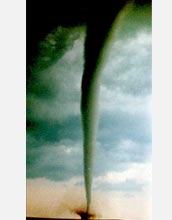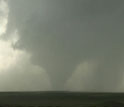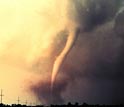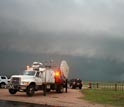News Release 09-061
Largest Attempt in History to Understand Tornadoes Slated to Begin
Nationwide tornado experiment underway in May

Atmospheric scientists soon will conduct the most ambitious tornado field project in history.
April 7, 2009
This material is available primarily for archival purposes. Telephone numbers or other contact information may be out of date; please see current contact information at media contacts.
An ambitious project to explore the origin, structure and evolution of tornadoes will take place from May 10-June 13, 2009, across the central United States.
The project, VORTEX2 (V2), is the largest attempt in history to study tornadoes, and will involve more than 50 scientists and 40 research vehicles, including 10 mobile radars.
Verification of the Origins of Rotation in Tornadoes (VORTEX2) is funded by the National Science Foundation (NSF) and the National Oceanic and Atmospheric Administration (NOAA), and involves scientists from NOAA, 10 universities and three non-profit organization
Researchers will sample the super-cell thunderstorms that often form over more than 900 miles of the central Great Plains.
Areas of focus include southern South Dakota, western Iowa, eastern Colorado, Nebraska, Kansas, the Texas panhandle and western Oklahoma.
"An important finding from the original VORTEX experiment was that tornadoes happen on smaller time and space scales than scientists had thought," said Stephan Nelson, NSF program director for physical and dynamic meteorology.
"New advances from VORTEX2 will allow for a more detailed sampling of a storm's wind, temperature and moisture environment, and lead to a better understanding of why tornadoes form--and how they can be more accurately predicted."
NSF has contributed $9.1 million to VORTEX2.
The original VORTEX program, operated in the central Great Plains during 1994 and 1995, documented the entire life cycle of a tornado for the first time in history.
Recent improvements in severe weather warning statistics may be partly due to the application of VORTEX findings.
V2 will build on the progress made during VORTEX and further improve tornado warning skills and short-term severe weather forecasts.
Data collected from VORTEX2 will help researchers understand how the large-scale environment of thunderstorms is related to tornado formation, according to Louis Wicker, meteorologist at NOAA's National Severe Storms Laboratory and a V2 co-principal investigator.
Participating scientists and students are from organizations throughout the United States and three countries, including the Center for Severe Weather Research, Rasmussen Systems, NOAA National Severe Storms Laboratory, OU/NOAA Cooperative Institute for Mesoscale Meteorological Studies, NSF-sponsored National Centers for Atmospheric Research, Penn State University, University of Oklahoma, Texas Tech University, Lyndon State College, University of Colorado, Purdue University, North Carolina State University, University of Illinois, University of Massachusetts, University of Nebraska, and Environment Canada and the Australian Bureau of Meteorology.
For more VORTEX2 news coverage, see http://www.nsf.gov/news/newsmedia/vortex2/index.jsp.
-NSF-
-
View Video
Genesis and evolution of a rain-wrapped tornado observed by VORTEX2 teams in southeastern Wyoming.
Credit and Larger Version -
The 1973 Union City, Okla., tornado was the first captured by Doppler radar and chase personnel.
Credit and Larger Version -
Today scientists use such instruments as the Doppler-on-Wheels to study tornadoes.
Credit and Larger Version
Media Contacts
Cheryl Dybas, NSF, (703) 292-7734, email: cdybas@nsf.gov
Keli Tarp, NOAA, (405) 325-6933, email: keli.tarp@noaa.gov
Related Websites
VORTEX2 Project: http://www.vortex2.org/
The U.S. National Science Foundation propels the nation forward by advancing fundamental research in all fields of science and engineering. NSF supports research and people by providing facilities, instruments and funding to support their ingenuity and sustain the U.S. as a global leader in research and innovation. With a fiscal year 2023 budget of $9.5 billion, NSF funds reach all 50 states through grants to nearly 2,000 colleges, universities and institutions. Each year, NSF receives more than 40,000 competitive proposals and makes about 11,000 new awards. Those awards include support for cooperative research with industry, Arctic and Antarctic research and operations, and U.S. participation in international scientific efforts.
Connect with us online
NSF website: nsf.gov
NSF News: nsf.gov/news
For News Media: nsf.gov/news/newsroom
Statistics: nsf.gov/statistics/
Awards database: nsf.gov/awardsearch/
Follow us on social
Twitter: twitter.com/NSF
Facebook: facebook.com/US.NSF
Instagram: instagram.com/nsfgov





